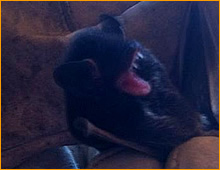Keen’s Myotis, Bat Removal & Control (a.k.a. Keen’s Bat)

Keens Bat Removal and control is a specialized service that should only be performed by a professional bat exclusion and removal expert. These are very sensitive animals and great care should be taken with them.
Bat in the house!
If you’ve had a bat or two appear in your house, or if you’re hearing noises you suspect are made by bats, a little bit of investigation will go a long way. Depending on the time of year, it may be an isolated incident, or evidence of a resident maternity colony; here’s how to tell the difference, and how to proceed in either case.
Keen's myotis is a medium-sized, long-tailed bat, found near coastal forests in the US in Washington state and Alaska. It roosts in caves, rock crevices, tree cavities, and under tree bark in the summer, sometimes in small colonies. Larger groups of Keen’s myotis form colonies to hibernate together in the winter, sometimes alongside other species of bats. Unfortunately for the homeowner, they will roost in buildings and attics as well.
Like many bats, Keen’s myotis hunt insects at night and are most active shortly after sunset and shortly before dawn. If you think you have bats in the Attic, Call a professional, You can find a professional bat removal company here.
Hearing Noises? Identifying the Culprit
First of all, is essential to verify that a nuisance is caused by bats, and not some other animal. Scrambling, scratching, and thumping sounds coming from attics and walls may be caused by rats, mice, or flying squirrels. Twittering and rustling sounds in old chimneys, often attributed to bats, may be caused by chimney swifts. Bats often become noisy before leaving their roosts at sunset and may chatter on hot days when they move down attic walls to seek refuge from heat. Thus, an increase in chirping noises about dusk probably indicates bats.
Here’s when you pull out the lawn chairs, lemonade, and bug repellent, and sit outside to watch your house around sunset time. If the "bats" swarm and enter the chimney at dusk, most likely these are swifts; a chimney cap will go a long way towards dealing with that problem. Bats will be seen leaving 15-45 minutes after sunset in midsummer. Make note of all the exits the bats are using, and make an approximate count of about how many bats you have (this is important for setting up bat boxes later on). During daylight hours, look for dark staining or smudges along the roofline; these may be places where bats are entering the building, where the oils in the bats’ fur has rubbed off.
Keen’s Bats in Early Fall
The discovery of one or two bats in a house is probably the most frequent problem. Keen’s myotis often enters homes through open windows and doors, but may use any crevice it can find. This usually occurs in the early fall when bats are checking for potential roost or hibernation sites. Keen’s bats may also appear in midwinter during a warm weather spell.
Keen’s Bat Appearances in Mid to Late Summer
Repeated occurrences of bats in your living spaces in mid to late summer suggest that a maternity colony is close by, most likely in the attic. As juvenile bats begin fending for themselves and exploring, one may explore its way into your living room. The presence of any bat in your living spaces is purely accidental; it is often a simple matter to allow it to escape.
Letting Them Out
Any bat will usually find its own way out; jut open all windows and doors leading to the outside. Bats usually will not attack a person even if chased. Never swat or throw things at the bat, or run around waving. All this tends to do is confuse the bat and leave you exhausted. Above all else, calmly watch the bat to make sure it leaves. If the bat refuses to leave, it will calm down and land on something. Drapes and hanging clothes seem to be the preferred rest areas. Place a small box or can over the bat, then gently slide thin cardboard under the "trap" to collect your bat, then release it outside. At last resort, local health authorities can be called to collect the bat, though this may result in its demise. If the bat, or any wild animal, has come in contact with pets, children, invalids, etc. contact your local health department. Health department recommendations vary from state to state.
Keen’s Bat Exclusion
These are animals that can hone in on a single mosquito flying through the air; a ½ inch crack in the side of a house is easy for them to find. The first step in dealing with a bat infestation is to watch after sunset to see where the bat entrances to the home are, then sealing up all but one or two of them. Then install bat boxes, and plug the remaining entrances with paper after the bats have exited the building for the evening to prevent them from reentering the structure. Remove the temporary plugs in the evenings to allow any remaining individuals to escape, or have one-way exclusion devices installed.
Professional Measures
There are several ways a professional bat abatement company can help. Look for a company who:
· has years of experience finding all the tiny entrances bats use to enter and exit a structure, and in sealing up those gaps.
· can quickly and efficiently clean up accumulated bat guano and urine, which poses a significant health risk if not dealt with properly.
· uses only the most effective exclusion and removal techniques, in compliance with all state and local regulations.
The picture above is not a Keens Bat, It is only there for referance of a bat!
We have many pages on several different species of bats, please use our main bat removal page for specific species of bats needing controlled.
